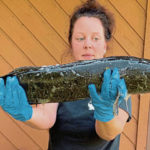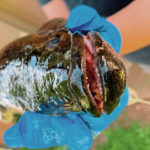The Pennsylvania Fish and Boat Commission confirmed Monday that an invasive species, the northern snakehead fish, was recently caught in the Monongahela River.
It is the first confirmed snakehead fish in Southwestern Pennsylvania, according to Kris Kuhn, chief of the fisheries management division for the commission. The invasive fish has a snake-like appearance with its sleek shape and pattern of coloring. It is known to reside only in the southeastern corner of the state, according to the agency.
Native to China, Russia and South Korea, the snakehead is a predatory fish that competes with native fish for food, potentially impacting their populations. Pennsylvania law prohibits the possession, sale, purchase and transport of live snakeheads.
“The big thing is the snakehead is a predatory fish that will compete against other fish in our three rivers, including smallmouth bass, walleye and sauger,” said Gary Smith, area fisheries manager of the commission’s southwest region.
“It’s like having another person at the table to eat, but there’s only so much food,” he said.
They have been called “Frankenfish” and “fishzilla” because of their rugged reputation as aggressive and voracious feeders. They are prolific breeders. Snakeheads look similar to the bowfin fish with a single dorsal fin running the length of their upper body. But snakeheads have a long anal fin that stretches from stomach to tail. They’re tasty, too, according to anglers.
The first detection of snakeheads occurred in the state in 2004 in a small pond in Philadelphia near the mouth of the Schuylkill River, said Mike Parker, communications director for the commission.
The origin of snakeheads in Pennsylvania is unknown, Parker said. They were likely introduced through the pet trade or food industry. Once a popular freshwater aquarium fish, snakeheads may have been dumped into local waterways by pet owners who no longer wanted them, establishing a breeding population, Parker said.
Since snakeheads are considered good to eat, they may have been imported by individuals as a food source, with unwanted specimens being released into Pennsylvania waters, he said.
An angler caught the snakehead in Pittsburgh’s Duck Hollow section of the Monongahela River last week, according to social media reports. The angler killed the fish, which anglers are supposed to do if they catch one, to make positive identification. He took a photo, stowed the fish in a freezer and reported the catch to the Fish and Boat Commission.
The fish was examined Monday at the commission’s southwest regional office in Somerset, according to Smith.
The snakehead, at 28 inches long, is at least several years old, he said
The fish was likely put in the river illegally, as there are no connecting populations in the area, Kuhn said.
The Monongahela snakehead is being treated as a single fish find because there is no evidence of an established group of fish, Smith and Kuhn said.
“It’s not total panic mode,” Smith said. “We’re not too alarmed at this point, as we don’t know if they are established.”
If they are or become established, it will be difficult to prevent their expansion given the size of the rivers’ fisheries area, Kuhn said.
“If you come across an invasive species in a smaller pond, you can use a toxicant or mechanically remove them with nets,” he said.
But that is not case with an expansive waterway like the three rivers. If the fish would become established in the three rivers, it would be a blow to the “progress in getting our native species back given our history of polluted rivers,” Smith said.
The commission is asking local anglers to keep an eye out for the snakehead fish, report it to them, and to keep the dead specimen frozen for later examination. The southwest region office can be reached at 814-445-8974.
“The anglers are out there every day, and they have a better chance of coming into contact with a snakehead,” Smith said.
Anglers are encouraged to learn how to identify the snakehead by visiting the Fish and Boat Commission’s webpage on the northern snakehead.











